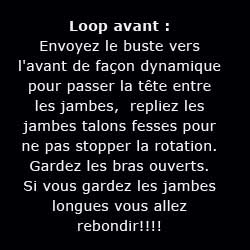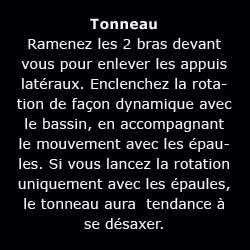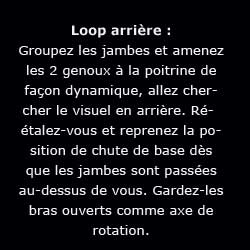ELEVES EN PROGRESSION : quelques conseils
Objectifs et exercices demandés pour le Brevet B
Avoir 22 sauts en chute minimum
Les figures du Brevet B en images
“Exercices à réaliser en chute pour le brevet B” : Aptitudes demandées en chute libre
➢ Maîtrise des évolutions autour des 3 axes : loop avant, loop arrière, tonneau, tour.
➢ Dérive efficace : qui avance dans un axe contrôlé, sans piquer, sur un axe défini perpendiculaire à l’axe de largage
➢ Repérer et respecter la perpendiculaire à l’axe de largage pendant l’exécution des figures , surtout la dérive
➢ Savoir sortir face moteur
Pour valider ces exercices, il y aura 1 saut suivi vidéo à partir du 22e saut et un saut à 1500 m avec une sortie face moteur (surtout quand tu te sens prêt).
La Dérive : Prenez une direction perpendiculaire à l’axe de largage Ramenez doucement les bras près du corps, paumes des mains vers le sol, en gardant les bras souples. Allongez les jambes et renforcez la position en décambrant progressivement. La position doit être tonique ( Vous êtes efficace si vous sentez l’air appuyer sur les tibias).

“ Knowledge of the release axis to have for PATENT B ”
Axe de largage – Objectif : éviter tout risque de collision entre un chuteur et un parachutiste sous voile
BEFORE GETTING ON THE PLANE: I know the release axis
Before getting out of the plane, I check the axis and I take a visual on one of the wing tips of the plane = mark perpendicular to the release axis, for all exercises and in particular drift jumps and free fly (back fall, sitting, etc.).
After the opening: thanks to the rear risers or immediately after the implementation with my controls, I orient myself at 90° from the release axis, until the opening of the following parachutists: I thus avoid going up the release axis with my wing. Then I orient myself in relation to the wind to reach the area of evolution.
Improvement under sail:
1/Opening of the visual field
Recherche des autres voiles : combien de voiles en l’air, que font-elles ?
Différences de catégories de voiles/ priorités : élèves, tandems, moniteurs et parachutistes experts, autres…
2/ Etagement – Objectif = éviter tout risque de collision sous voile dans le circuit d’atterrissage
repérer les voiles à mon niveau
– si j’ai une catégorie de voile inférieure ou égale, je m’étage :
– soit vers le haut : je freine
– soit vers le bas : je fais qq tours alternés pour descendre + vite tant que je suis au-dessus de 500 m
if I have a doubt for the landing (proximity of another wing), I can change zone (for example, land on the other side of the runway)
3/ Exercices sous voile
The exercises should be done:
- au-dessus de 500 m avec les commandes à la main
- while remaining in its zone of evolution
- keeping the visual on the other sails
- be briefed and debriefed by an instructor
Do not exercise in strong winds
Examples of briefed exercises:
➢ Travail aux commandes ( 50% freins, relâchement)
➢ Virages 360 ° à la commande (enfoncement)
➢ Pilotage aux élévateurs arrières (360°)
➢ Découverte des élévateurs avants (90°)
➢ Autre exemple : jouer avec le poids du corps dans le harnais
➢ Découverte du point de décrochage
➢ Prise de terrain en PTS
4/ Atterrissage : Objectif : Se poser correctement et en sécurité
- Prepare your circuit: minimum 500 m (tiering, positioning in the evolution area to prepare the landing circuit, depending on the wind, etc.)
- If there is traffic, anticipate the trajectories of other skydivers so as not to get in the way.
- Si je suis trop haut, je peux rallonger mon circuit
- Je respecte le sens de la flêche et donc le circuit pour éviter de me retrouver face à une autre voile
- If in the final phase, I am too long, I can make S's provided I do not interfere with the sails following me (I risk blocking their passage) and not being too close to the ground
- En cas de posé hors zone, je me décide le plus tôt possible, je choisis une zone dégagée, je me pose dans la plus grande longueur, loin des obstacles, et je fais attention aux lignes électriques.
- si j’ai un doute pour l’atterrissage (proximité d’une autre voile ou mauvais sens d’atterrissage), je peux changer de zone (par exemple, me poser de l’autre côté de la piste) POUR EVITER LES OBSTACLES.


